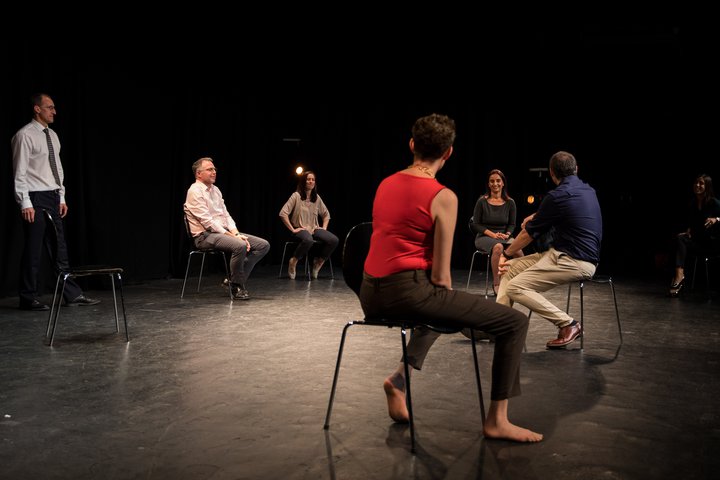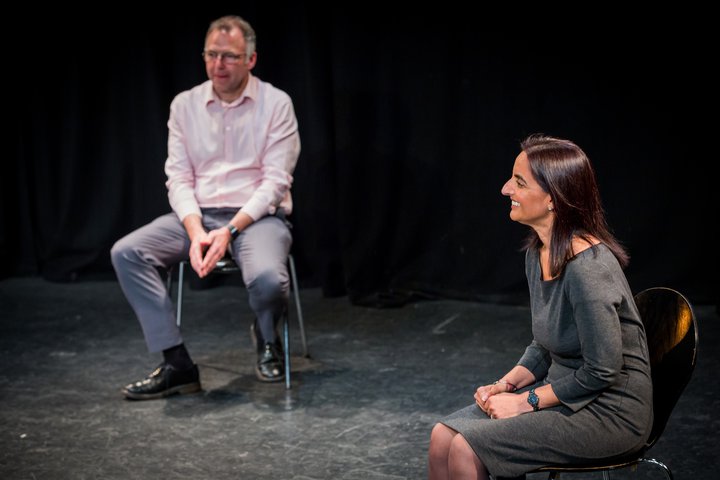Remote Intimacy: How to lead at a distance
Friday, 17th July 2020Why leaders need to create new ways of maintaining connection in today’s virtual world
By RADA Business tutor Claire Dale
Even before lockdown, leaders were getting to grips with how best to maintain connection through video conferencing tools. Virtual town hall meetings were becoming more common, and as a result the moments that happen when teams come together to spend time with their leaders were already becoming more special. It is inevitable that, when such moments happen rarely, we invest more of our time and energy on them.
Stating the obvious, this trend will only continue as we emerge from lockdown. With more and more communication happening remotely, when we do come together in person, I believe the opportunity and perhaps even the thrill of being together in the flesh will be heightened. We’ll probably invest in these moments even more, making these experiences special in many different ways. For example, flying to a global all-team meeting, or having an offsite event will be a novel occasion that generates a lot of creative energy.
If leaders are creative with these new opportunities, then engagement, innovation, and purpose will blossom. Our physical presence can become a tool for injecting a boost of feel-good chemistry into the lives of teams and organisations, enhancing how they can think together as a community.

But it is very likely that, for the majority of the time – and at least for the foreseeable future – our stage, our office, our meeting room, or our coffee lounge, is mostly going to be a rectangular screen, a camera and a microphone. Our attendance will rely on having enough bandwidth to stay online and enough time to stay present, negotiating space with our family members as we go.
I have been tracking what this really feels like and thinking about how can we make the most of it. And I have been listening to stories, as well as coaching a number of global leaders on this topic.
Body language and breath: how we read others
When we are meeting people face-to-face, we as human beings are able to read the bodies of others effortlessly. This means we can instinctively work out whether we trust them. We are looking for the other person to be present with us, to look at us with a quality that says “I see you,” “I am listening to you,” “I am not going to harm you,” and furthermore “I care about you, and have your best interests at heart.”
However, when we are making this initial reading of someone – their grounding, their breathing pattern, the quality of their eye contact and the tone of their voice – through a computer screen, it is so much more difficult to compile. There might be a slight distortion of image and sound, as if the person has been teleported and is not completely formed. Another thing I’ve realised, which is central to all of this is, is that when we take part in a virtual meeting or discussion, we can’t hear each other breathe.
In the real world, when we are sat together around a table there are many cues. A swift intake of breath that is audible to those sitting nearby lets us know that someone is about to speak. It may be relief or frustration, so most of us will immediately look to see what that person is intending.
This is just one of the indicators we can take from breath – there are a multitude of others.

Adapting for the virtual stage
This, combined with the fact that we can only see a small section of each other’s bodies flattened into two dimensions in an on-screen image, makes virtual communication feel more surface and lacking in depth.
For many types of conversations, virtual communication is perfectly adequate. Some people enjoy the social safety of communicating from their own homes, finding that they expend less energy overall. I feel that too. But bearing in mind that, as leaders, we need to be able to make others feel and care as well as understand, and that many of us are forming completely new relationships through our video screens – relationships where there is no history of actually being present with people – how can we create more depth?
I think the phrase Remote Intimacy might come close to what we need to create – because we need something new to use instead of relying on face-to-face presence, given we want people to trust once more. This is especially vital for new leaders who are meeting their teams virtually for the first time, and it is a far more challenging prospect than for leaders who already knew their teams before lockdown.

Try these steps to develop Remote Intimacy
Stage one
- Start to think about your language. Use words like ‘feel,’ ‘listen,’ ‘share,’ ‘tune in’ and ‘sense.’ This will go some way to help stimulate the kind of attention to non-verbal aspects that make us feel close to one another.
- Get closer to the screen. I realise that we are all getting better at having our cameras at eye level – looking into the camera lens, filling a third of the screen, being front lit, being aware of the background, sitting tall and present, being focused and much more. We have shared tips about these techniques previously, and of course they are very helpful for enabling clear communication. But sometimes, if it feels appropriate for certain types of conversation, invite people to bring their faces closer to their cameras in order to listen to each other. Seeing someone’s face close up can provide some of that texture we are seeking.
- Tell your story. Start priming yourself to share one or two more personal details as you go about your leadership to create closeness and trust. One leader I heard about recently took some time at the end of a global meeting to share the fact that his wife had fallen and broken her wrist. Whereas previously the ironing was on her to-do-list, he shared the fact that it was now on his list for the foreseeable future – and he turned his camera to show the team the pile of ironing on a sofa off to one side of him. This was much talked about and people drew near him.We’ve known for a long time that stories create pictures in people’s minds and that they can help audiences truly engage with the person and journey ahead. This leader was using the visual and aural aspects of storytelling to stimulate people’s imaginations and empathy. He didn’t do this in a calculating way, but the image of him doing the ironing and his wife’s broken wrist made him human, humble and relatable. This dislodged the two-dimensional impression of him on the screen and replaced it with a memorable image of his humanity. So get used to easing personal and professional boundaries and let people in. A little goes a long way – you don’t have to share anything you are not comfortable with, but try to share something if you can.
Stage two
- Tune in. To help with this, work on developing a deep inner self-confidence. Ground yourself, breath well, release unhelpful muscle tension and sit still, comfortable and at ease for extended periods, showing that you are giving teams your full attention. Continue to tune in and listen to the nuances of how people are feeling, by calming and quietening your own inner-state.
- Be assertive. Whilst doing all the above, we also need to be well-planned and efficient with how the collaborative aspects of any online meeting will work. Round table discussion just doesn’t happen in the same way, so I find that when leading sessions, I have to be comfortable being assertive and moving things on swiftly, even if I simply can’t see how things are landing with people and not all voices have been heard. Using chat boxes for people to be able to state what they need in the meeting is good protocol. Clarity is everything.
- Breathe while others are talking. Concentrating hard on trying to read the room through technology is so different compared with face-to-face meetings, and a lot of people I am coaching report feeling fatigued. Many are holding their breath on conference calls due to the level of attention required of them. Set your breathing pattern before the meeting to be released and easy, open your eyes and your senses, and relax and be easy with all the imperfections in communication we are all facing.
- Don’t hide away. Be easy with the clashes between home life and work meetings. We’ve all been talking about how nice it is to glimpse people’s partners, children, pets and bookshelves – and whilst you don’t want intrusions to dominate too much, it can create a sense of closeness and familiarity that also builds ease and trust. You team members feel more engaged if they know a little about who you are.
- Finally – imagine the people where they are. Spend a few moments visualising them prior to the meeting. Then engage, using your eyes to connect through the camera lens. Reach out through the camera to speak with them as if you could look into their eyes, and use your body expansively, as if you were holding a whole room. Use variation in your voice, commit with passion to the words you are saying, and articulate clearly so that the fibre-optics dance to your tune – rather than you dancing to their deadening monotone.
Welcome to our Virtual Stage
Find out how Claire and our expert team of tutors can help you to refine your leadership whilst you’re performing on a virtual stage by taking a look at our range of virtual training solutions, including one-to-one coaching and performance programmes.
Alternatively, contact us on +44 (0)20 7908 4830 or [email protected].